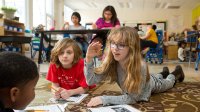A Framework for Personalized Learning Days
When fifth-grade co-teachers gave students more autonomy over their learning, their reading and time management skills improved.
Your content has been saved!
Go to My Saved Content.Some might say “personalized learning” is just a buzzword; some might call it the next teaching fad. In reality, we personalize learning for students every day. We call it many different names, such as what-you-need time, student-centered learning, and structured independent work time.
All in all, we know that differentiating for students to meet them where they are is best practice. This practice can be difficult in a typical year, but my co-teacher and I had to get really creative to make it work during the pandemic.
We came up with a way to give our students personalized learning days (PLDs) where they could choose from a list of tasks to complete on their own time throughout the day. While they did this, we would confer with all students about their learning and pull small intervention groups. Throughout the year, we reflected on our practice and improved our methods. By the end of the year, we were shocked by our students’ growth.
3 Tips for Implementing PLDs
1. Start slow, then fade support. At first, we gave our students the freedom to plan how they completed their tasks one subject at a time. Once they mastered planning and completing their work for one subject, we would add multiple subjects. Eventually, students spent one day a week working independently through various content areas while we pulled small intervention groups.
One way to scaffold this for the students when scheduling the multisubject PLDs is to create a must-do, may-do list. This gave the students a place to start each day. It helped them create a prioritized list while still allowing them to choose what to work on after completing the must-do portion.
2. Allow for failure and reflection. We gave students the freedom to fail, but we reflected on these failures and grew together. Some of them had never experienced planning out to-do lists. Especially in the beginning, there were times when some students didn’t make it past the first task, and they said they thought they had more time to finish everything else.
I think everyone can relate to an unfinished to-do list. It’s essential to let students learn from their personal experiences with time management, but it’s even more critical to reflect on improving next week.
Throughout the PLD, we can confer with each student at least once. This time provides a great opportunity to develop a plan for completing the daily tasks. We can reflect on our personal goals with the students and model executive function skills that lead to practical task completion. Reflecting with the students also creates a growth mindset within our classrooms. This is an even more critical skill to instill in our students.
3. Allow them to explore their passions in learning. We let our students explore what they were passionate about and chase it, creating what many call a "genius hour.” As we were in full swing of our personalized learning days, we found that some students had extra time because they could complete the tasks quickly. We started by letting them choose chapter books to create projects from a menu we had given them. We saw that they were excited about this and enjoyed having more choices in learning and reading.
Over time, we slowly gave the reins to the students more and more. When they completed the necessary work for the week, we let them explore things they were passionate about. Some stuck with wanting to read more books, some wanted to explore more scientific phenomena, and some decided to learn more math and become an expert.
Once they found their passion, we let them explore it independently as long as they produced some way of showing us that they were still learning. This can be as large as a full-blown exhibition project that they presented to us or the community or as small as showing us a new strategy they learned for math during one of our conferences. This time is not about creating elaborate projects but about instilling a love for learning.
We expanded on these three small ideas throughout the year, and in an academically diverse classroom, we saw some fantastic breakthroughs by the end of the year.
When we started, we had about 86 percent of our students not on track to reach grade-level reading. After a year of PLDs and other differentiated instructional practices, we finished the year with only 25 percent of our students not reading on grade level. Not only did these personalized learning days impact our students’ data, but also we saw some tremendous personal growth in our students as learners.
By their fifth-grade year, many of our students already had a distaste for school. They would see the work and give up before even trying. At the end of the year, we had instilled a growth mindset in all of our students. They knew the importance of learning and accepted when they failed with pride. As a community, we learned together, failed together, and grew together.
